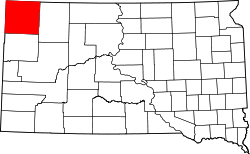Harding County | |
|---|---|
 | |
 Location within the U.S. state of South Dakota | |
 South Dakota's location within the U.S. | |
| Coordinates: 45°35′47.8″N103°28′25.935″W / 45.596611°N 103.47387083°W | |
| Country | |
| State | |
| Founded | 1881 (created) 1898 (dissolved) 1908 (re-created w revised shape) 1909 (organized) |
| Named after | J. A. Harding |
| Seat | Buffalo |
| Largest town | Buffalo |
| Area | |
• Total | 2,678 sq mi (6,940 km2) |
| • Land | 2,671 sq mi (6,920 km2) |
| • Water | 6.5 sq mi (17 km2) 0.2% |
| Population (2020) | |
• Total | 1,311 |
• Estimate (2024) | 1,325 |
| • Density | 0.49/sq mi (0.19/km2) |
| Time zone | UTC−7 (Mountain) |
| • Summer (DST) | UTC−6 (MDT) |
| Congressional district | At-large |
Harding County is a county in the U.S. state of South Dakota. As of the 2020 census, the population was 1,311, [1] making it the third-least populous county in South Dakota. Its county seat is Buffalo. [2]
Contents
- Geography
- Major highways
- Adjacent counties
- Protected areas
- Lakes
- Demographics
- 2020 census
- 2010 census
- Politics
- Communities
- Towns
- Unincorporated communities
- Ghost towns
- See also
- References
Harding County was established as a county in the Dakota Territory on March 5, 1881, but was not organized at that time. Its name recognized J. A. Harding, who had been Speaker of the House of Dakota Territory. [3] Its boundaries were altered in 1883, in 1889, and in 1894. On November 8, 1898, Harding County was dissolved and its territory assigned to Butte County. However, on November 3, 1908, it was again created (with altered boundaries) from Butte County's area, and on February 17, 1909 its governing organization was completed. [4]
Custer National Forest has its South Dakota portion in Harding County, and South Dakota State University operates the Antelope Range and Livestock Research Station about 14 miles (23 km) east of Buffalo.
